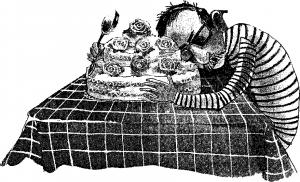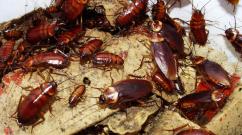Why do entire families of bees die in the fall? Why do bees die after being stung? Canada is about to reconsider its attitude towards neonicotinoids
In the last decade, in apiaries in many European countries and some countries North America such an unpleasant and incomprehensible phenomenon as the mass death of bees was noticed.
Beekeepers around the world have sounded the alarm. It was even noticed that when the apiary leaves for a nomadic place, insects are in no hurry to make a test flight and may even die of hunger when there is an abundance of flowering honey plants around the apiary.
Entomological scientists have discovered the cause of the mass death of bees. It was found that this was by no means the varroa mite, a widespread disease that leads to the death of bees in many apiaries.
Causes of death of bees
- The main reason for the death of bees is that farmland is treated with a new generation of pesticides - neonicotinoids - to protect them from insect pests. These are highly toxic poisons. In addition to vegetable crops, hedges, forests, surrounding fields and meadows began to be treated with such substances. Moreover, the processing period coincides with the flowering period of honey crops.
- Another barbaric reason why bees die is commercial. In industrial apiaries, it is customary to pump out honey so completely that families are left without supplies of natural food for the winter. It is replaced with sugar syrup. Because of this, insects become so weak during the winter that they do not reproduce well, which also leads to the mass death of bees.
- The third reason why mass mortality of insects occurs is their lack of a variety of plants to collect nectar. This was proven two hundred years ago by the beekeeper-researcher who founded beekeeping on an industrial scale, P.I. Prokopovich. He believed that one apiary should have no more than fifty hives. Many modern beekeepers began to adhere to this idea and actively arrange a good base of honey plants around their apiary.
- Another reason why bees die is that their resistance to infections is reduced due to the use of antibiotics in the fight against the same diseases. You should not get carried away with the use of these drugs, as this leads to the formation of resistant strains of infections and the death of bees. Antibiotics tend to accumulate in beekeeping products, this has also been proven by numerous studies.
What will this lead to?
Apimondia - the international federation of beekeepers - based on the results of its research, presented data that states that in Europe about 30% of all honey workers die in just one year. The mass death of bees can lead to the loss of pollinators for many agricultural plants, and consequently to their complete disappearance.

Pesticides applied to fields against weeds do not kill bees, but make them vulnerable to mites. Well, scientists from Germany have a lot of evidence that the death of bees is influenced by radio signals from cellular networks. They disrupt the bees' orientation system, and they cannot find their way home to the hive and die.

In countries where the greatest decline in bees has been recorded (USA, Canada, China, Australia, some European countries), genetically modified plants are grown en masse. Of course, bees cannot pass them. At the same time, the source of their genetic infection is not only pollen and nectar of GM plants, but also feeding from sugar produced from GM beets. When young bees consume GMOs, they experience destruction as adults. internal organs and decreased immunity.

The world changes - the bee changes and disappears. It is now common knowledge that, compared to the United States, the situation with bees in the UK is still better: in recent years, the bee population here has decreased by about a third. And the threat of complete extinction of the honey bee in this country is predicted in the next decade.

Dead bees do not buzz... Their mass death, which ecologists in a number of countries are already sounding the alarm about, could lead to the disappearance of many plants, including agricultural crops. After all, almost 80% of them are pollinated by honey bees. Therefore humanity is waiting big problems. Although attempts are being made to somehow get out of this situation. Let's say there are “breeding ideas” in the air. Thus, some scientists propose to derive new look bees resistant to any disease by crossing ordinary honey bees with aggressive Africanized bees that have strong immunity.

Science fiction writers, meanwhile, paint such a picture of saving the planet in the event of the disappearance of bees, people en masse go out to fields, meadows and carry out artificial pollination of plants. But where the bee flew, a person could not reach. For everyone has their own purpose. There is still time to stop the Great Chaos and Human Madness in relation to the environment. Already the bees, as we see, give an alarming “SOS!” about this.

In the winter of 2002/03 in the European part Russian Federation An unprecedented number of bee colonies died. The decline by spring in many apiaries in the Volgograd, Vladimir, Voronezh, Ivanovo, Penza, Rostov, Ryazan, Oryol, Saratov, Tula, Tambov regions, Bashkiria and Tatarstan, as well as a number of other regions, ranged from 30 to 80%, and often more. Moreover, in most cases, from 10 to 25% of families died in the fall, 20–30% in the winter, and 40–60% in late March-April. This did not happen even at the beginning of the varroa epizootic (1974–1977)
To avoid similar tragedies in the future, it is necessary to reveal the causes of this phenomenon.
Regarding the “sudden” disappearance of bees in families in the fall noted by beekeepers, which they describe in their numerous reports as a “gathering for an unknown reason,” I will say that, with rare exceptions, there was no gathering of families. This characteristic is just an expression of the helplessness and fortune-telling of beekeepers, if only because during gatherings, colonies with queens leave the hives in the same way as swarms, but are grafted much closer to their hive than during swarming, due to the fact that the queens, like As a rule, they turn out to be heavier and unprepared for flight. Such “swarms” can remain on scions much longer than real ones. Surprisingly, there were no eyewitnesses to this last fall. If queenless colonies fled, beekeepers would notice a significant increase in adjacent colonies. But this was not observed either. Consequently, there were no mass gatherings last fall. Then where did the bees go?
Let's remember the features of last season. The cold weather that persisted until mid-June led to a sharp shortage of food supplies in the nests. The queens were unable to develop normal egg production either at the end of May or in mid-June. At the beginning of June, there was 30–40% less brood in the families than is usually the case at this time. From mid-June it became hot and dry. In various regions in June-July, the arrival of honeydew into bee nests was noted. Due to increased heat and drought in mid-July, colonies sharply reduced brood rearing, and at the end of the month, most queens almost completely stopped laying eggs, and as a result in August, only “patchlets” of printed brood were found in the nests.
From spring to autumn there was bee theft, which reached its climax in August - September. Reconstruction work by bee families was carried out minimally: units rebuilt 3–5 honeycombs per season, which is more than 2 times less than the average annual indicators. There was no swarming in most of the apiaries, the majority of the colonies failed to replace the queens, and, naturally, by the fall they ended up with the old mothers. Against this background, ascospherosis and foulbrood often appeared in families, varroatosis intensified, and wax moth progressed. The condition of families at the end of summer was aggravated by a sharp increase in the wasp population, who not only in the early morning, but also in the middle of the day, robbed weakened families.
The reason for the sharp (even death) weakening of colonies at the end of summer is the exhaustion, exhaustion and physiological aging of bees. The share of influence of these factors on the results of the past winter presumably exceeded 60–80%.
According to our research, the majority of bees entering winter are those whose emergence from brood occurs between the second half of August and the second half of September. On average, 76–96% of the bees emerging from this brood go to winter. Those born in early August - late September survive the least until winter.
From the above it follows that colonies consisting of bees hatched in July and hatched in August at the beginning of autumn are not able to winter normally. This is the main reason for the wintering tragedy of 2002/03.
To confirm the primary cause of the age factor (physiological old age of bees), and not epizootics of amoebiasis or deformed wing disease, I will say that if the above diseases had occurred, then they would have been recorded characteristic features: visible in the hives, near them, on the arrivals of bees, sagging, morphological changes in dying individuals. In addition, the listed diseases affect pupae and adults, but not eggs. However, in July last year, that is, at the time when the queens should be actively laying eggs, there were no eggs in the nests. Why did the uterus sharply shrink or completely stop performing this physiological function?
In my opinion, the reason lies in the following: for adequate feeding of the larvae and the queen, a sufficiently liquid feed with a significantly higher water content than in honey is required. With huge reserves of protein and thick (no more than 16–20% water) carbohydrate food in the nests during a very hot period, when the humidity in the home drops below the maximum permissible level, the bees stop raising brood, exhibiting cannibalism towards larvae and eggs. A similar situation arose in the second half of last summer. In addition, honeydew honey that got into the nests in June - July could cause a salt imbalance in the bees and brood that fed on it subsequently, which, in turn, would automatically lead to a disruption in the water balance. It is known that sodium ions contribute to the accumulation and retention of water in living organisms, and potassium ions, on the contrary, help remove it from the body. Honeydew honey contains 12.8 times more potassium than flower honey (N.G. Bilash, L.F. Solovyova, 2002). Increased content potassium ions probably leads to disruption of water-salt metabolism in the body of all representatives of the bee family. Last year's extremely long drought may have contributed to this negative effect. As a result, water deficiency occurred in the body of queens, bees, larvae and pupae, and physiological processes. The queens sharply limited or completely stopped egg laying. The larvae and pupae began to die and were eaten by bees. Thirst could cause severe exhaustion, weakness and death of adult individuals. All this was observed at the end of last summer.
To confirm this, I will give examples: at an experimental apiary located on the border of the Voronezh and Volgograd regions, a group of 12 families with a size of 11–12 streets was fed 1.5 liters of liquid (1:1) every two days from mid-August last year. sugar syrup for ten days. The other - control - was not given any additional feeding. Both groups were located at the same point not far from an array of wilting sunflowers, which, due to the heat, were almost non-producing nectar.
At the beginning of September, the experimental families had 38±12.8 square meters of printed brood more than the control families. In the experiment, all families left the winter quarters; the weakening amounted to 2–3 streets. In the eight surviving families of the control group at the beginning of May there were from 4 to 6 bee nests (0.8–1.5 less than in the experiment). Thus, it is clear that liquid carbohydrate feeding during the period of optimal rearing of winter bees and in hot, dry years helps to increase the amount of brood fed at this time and improve the results of wintering.
In the same summer and in the same zone, two apiaries of 90–120 families each stood on buckwheat and sunflower not far from each other. Due to the prolonged lack of rain, one of the beekeepers at the end of July moved his families about 40 km to an area of young sunflowers, where there had been good rain the day before. As a result of this additional migration, he not only received 10–12 kg more marketable honey per family, but also grew up full-fledged families by winter, which overwintered without waste. In his partner’s apiary, the death rate of families after wintering was almost 50%.
The previous autumn was relatively early and cold. As a result, the last cleanup flight ended 3–4 weeks earlier than usual. This year's spring turned out to be very late with frosty March and April. Therefore, many weakened colonies that had exhausted old bees since the fall were unable to survive such a long fly-free period and died.
In conclusion, I consider it necessary to remind you, dear beekeepers, that bees need to prepare for winter, and not rely on their self-preparation. This season, special attention should be paid to this also because many of you have restored your apiaries mainly due to imported bees of “southern blood” and, therefore, with clearly low winter hardiness. Wintering such bees requires additional preparation and compliance with a number of nuances.
V.A. ULANOVSKY
Recently, beekeepers are increasingly faced with the problem of mass death or flight of bees in the fall. This problem causes great damage to beekeeping. Therefore it needs to be addressed.
Why do bees leave the hive in the fall?
Beekeepers call the autumn gathering of bees a situation when an absolutely healthy and strong family suddenly, for no apparent reason, leaves a hive normally prepared for winter and flies away with the queen, leaving behind honey and printed brood. There are two types of bee gatherings:
- The family leaves the hive in a dense mass along with the queen. Sometimes the queen remains with a small number of workers. Honey and printed brood are usually in place. This phenomenon can be confused with swarming.
- Bees from one hive fly to another, leaving everything behind. At the same time, even without paying attention to the security.
Features of this phenomenon include:
- It occurs exclusively in the fall.
- Sometimes single families disappear, usually the strongest ones. But sometimes the entire apiary can fly off.
- Other bees do not steal the honey left by bees. But if the honeycomb is moved to another place, everything will be stolen in an instant.
- In an abandoned hive, not a single family can take root.
- Before they fly away, the family suddenly becomes strong.
- In one apiary, all families can fly away, but in the one that is nearby, everything is fine.
A clear answer to why this happens has not yet been found. It has been proven that the possibility of a colony with an old and worn-out uterus mating in the fall is higher than with a young and strong one. However, this, of course, is not the only factor causing the disappearance of bees. Many believe that this phenomenon is caused not by one reason, but by a number of factors. These include replacing honey with sugar in the fall, various viruses and infections, insufficient treatment against ticks, and much more.
Why is there mass death of bees?
 Experienced beekeepers identify several reasons that can lead to the death of bees. These include:
Experienced beekeepers identify several reasons that can lead to the death of bees. These include:
- Rainy summer, small number of honey plants. Such poor conditions for collecting honey throughout the summer, especially closer to autumn, as a rule, always contribute to the weakening of families. If the bees receive little nectar, then, starting around July, the colony will switch to the wrong food for it at this time of year - honey. And this is very bad. After all, the bees will begin to eat worse in order to spend the food prepared for the winter more economically. Nurses will produce less milk, which means there will be less food for the larvae. Accordingly, young individuals will be underfed, and they will not live long. As a result, there will simply be no long-living bees left in such a colony. By autumn, she will either leave the hive or die.
- Excessive spread of Varroa mites towards the end of summer. This pest is a real scourge for beekeepers. It not only weakens the worker bee’s immunity, but is also a carrier of many diseases. This pest is “able” to weaken some bee colonies so much that they will simply cease to exist. To avoid this, it is necessary to immediately, after the last pumping of honey, carry out high-quality treatment against this mite. In this case, the working individuals will be able to recover before wintering and will not die. Especially effective drug Lately it has been considered biping. It affects ticks within three hours after application. A properly selected concentration of bipin is not toxic to bees.
- The presence of viral and infectious diseases. Beekeepers commonly encounter deformed wing virus and melanosis. These diseases are transmitted by the notorious tick. The presence of a virus and infections can be determined by the disease. Melanosis is a common infectious disease, attacking the queen bee, it contributes to her death or the cessation of egg laying. This is why treatment with bipin against varroa is so important.
- Presence of pesticides on honey plants. Unfortunately, the beekeeper will not be able to influence this factor. The treatment of fields with pesticides is entirely the responsibility of our agricultural enterprises. This also includes the consumption of pollen from genetically modified plants by bees. Of course, if the field does not belong to the beekeeper, no one is obliged to ask him what to grow on it.
- Replacing honey with sugar in the fall. In general, the last honey should be left to the bees, but in some regions this is not possible for a number of reasons. But beekeepers should be aware that such actions can undermine the immunity of the working colony.
- Use of antibiotics to treat certain diseases. These drugs can reduce the immunity of all living organisms. In addition, you should also know that in many countries the use of honey with traces of antibiotics is prohibited. Fortunately, there are many other remedies for treating existing bee diseases.
- The presence of cell phone towers located near the apiary. It will also be difficult for the beekeeper to influence this factor. The only solution is to take her away from such a place, but this is not always possible.
- Inbreeding. Close inbreeding can lead to weakened workers. To prevent this from happening, you need to change breeding insects more often.
It is worth mentioning separately about feeding insects in large doses with sugar. Some have a very negative attitude towards this moment, calling it one of possible reasons death of bees. However, not everything is so simple here. In principle, in nature there are some honey-bearing plants, for example, sunflowers, that produce nectar, the composition of which differs little from the composition of ordinary sugar. That is, it consists of only carbohydrates, so its processing is identical to the processing of sweet syrup, which some beekeepers like to feed bees. Moreover, when a family is fed with sugar, it wears out less, because it does not need to obtain nectar. As a result, we can conclude that such feeding itself cannot cause the flight or death of bees. However, the timing of feeding is important. If bees preparing for wintering process large volumes of syrup, this can lead to their exhaustion. After all, at the same time they will spend their reserve funds stored for the winter.
If you do not make mistakes when breeding bees and follow all the recommendations, then problems such as flights in the fall and mass death of bees can be completely avoided.
by Notes of the Wild MistressYou can watch this video about the problems of bees flying and dying.
How to properly prevent diseases in the spring, watch this video.
What remains in the hive after the bees fly, watch this video.
This week, British beekeepers laid siege to Parliament and the residence of Prime Minister Gordon Brown, demanding more funding to combat the terrible scourge of the ongoing decline in bee populations. This week, British beekeepers laid siege to Parliament and the residence of Prime Minister Gordon Brown, demanding more funding to combat the terrible scourge of the ongoing decline in the bee population.
For last year it decreased by about a third. The head of government was presented with a petition with signatures of 140 thousand people concerned about the misfortune that has befallen the country, CNN reports citing the AP agency.
In the next 10 years, the UK could lose its honeybee population completely if the government and relevant organizations do nothing to protect these beneficial insects from the diseases that affect them. More than 40 thousand people are employed in beekeeping in the country.
The situation in the UK is still better than in the US. American beekeepers report 30 to 90% of swarm deaths each year, varying from state to state.
The fears of specialists are understandable and based on logic that is elementary for ordinary people: there will be no bees - there will be no pollination of plants - there will be no plants - there will be no humans.
Earlier this year, speaking in the House of Lords of the British Parliament, the Minister of State for the Ministry of Defense environment, Food and Agricultural Development Lord Rooker admitted: “We do not deny the fact that the health of bees is under threat and, frankly, if nothing is done to correct the situation, within 10 years the honeybee population could be completely decimated by this disease , like varroatosis (an invasive disease caused by the Varroa destructor mite
bees are not resistant to viral diseases and die - approx. ed.)".
Britain's honeybee population is also threatened by the expected "arrival" from Europe of a tiny hive beetle that is destroying the hive from the inside.
Lord Livesey, who participated in these hearings, noted that the problem of preserving the honey bee population is not limited to protecting these insects. Bees, he recalled, pollinate many crops, and without them there would be a serious threat to the entire agricultural sector of the British economy.
Bees have been dying out en masse across Europe for several years now. This could lead to the extinction of many plants: almost 80% of them are pollinated by the honey bee Apis mellifera and other wild bees. Beekeepers in the UK, Germany, Greece, Italy, Portugal, Spain, Poland and Ukraine are sounding the alarm.
Insecticides can destroy mites, but honey after such treatment cannot be sold: it may contain poison. Biologists from Germany propose using another protective agent - oxalic acid, which, if used according to the method they developed, destroys up to 95% of ticks.
However, the drug, created on the basis of oxalic acid, which is found in spinach and rhubarb, can hardly be considered a panacea, since, in addition to the ill-fated mite, bees have another enemy - modern agriculture.
According to another version, the cause of the mass death of bees in the USA and Europe may be radio signals from cellular networks. This conclusion was recently reached by scientists from the University of Koblenz-Landau, Germany.
German scientists have been studying the disorientation of bees near power lines for a long time. In a new study, they concluded that the radiation from cell phones and transmitting devices disrupts the bee's orientation system, it cannot find its way back to the hive and dies.
Perhaps the reason for the mass death of bees over the past two years is the increase in the density of coverage of large areas of the United States and Europe by cellular networks. The coverage density or signal strength could exceed a certain critical threshold, which led to disturbances in the orientation of the bees.
Dr. George Carlo, who heads the US government's research, last year called the German scientists' findings very convincing.
For its part, the Institute of Beekeeping named after. Prokopovich of the Academy of Sciences of Ukraine, they are sure that they will die from radiation mobile phones, as American and German experts, concerned about the deaths of bees in the USA and Europe, stated, Ukrainian striped insects cannot.
According to them, agronomists are to blame for the sea of bees when they use a certain French herbicide when cultivating rapeseed fields (most likely, we are talking about a drug with the active ingredient imidacloprid, which was banned in France back in 2003 - NEWSru.com), which poisons bees during pollination time. Scientists say that the situation may worsen as more rapeseed is grown in Ukraine, and herbicides are therefore used more often.
"We've seen a lot of cases over 40 years, but what's happening now is the epitome of everything at once," Dave Hackenberg, an apiary owner who works with bees in Fort Meade, Florida, told the AP. Analysis of bee necropsies revealed alarmingly high numbers of unfamiliar fungi, bacteria and other organisms.
And while scientists are trying to establish the cause of the disease, Hackenberg himself has organized a service for renting bee hives. After all, bees, he explains, not only give us honey. Their main purpose is to pollinate dozens of types of crops, including those vital to all Americans, such as citrus fruits, apples and nuts.
Now the trucks he and his son own deliver beehives all over the country, from orange groves in California to blueberry fields in Maine. Getting one hive for the duration of pollination costs $90, replacing a hive with dead bees costs $120. Hackenberg’s main requirement is complete absence pesticides on the customer’s lands and his neighbors.
In Russia, a mass death of bees was registered in the fall of 2007. Externally, the bee disease practically does not manifest itself in any way. But one day the beekeeper suddenly discovers an almost empty hive, and the insects themselves disappear without a trace.
In Russia, unlike the USA and Europe, common system There is no monitoring of bee health. But both Rosselkhoznadzor and regional veterinary services confirm the sad statistics - bees have never died in such numbers. But no laboratory research still not.
As noted earlier by the head of the beekeeping department of the Russian State Agrarian University - Moscow Agricultural Academy named after K.A. Timiryazev, Professor Alfir Mannapov, one cannot sit idly by, since this initially “American” problem may well become Russian if special significance is not given to it now.













